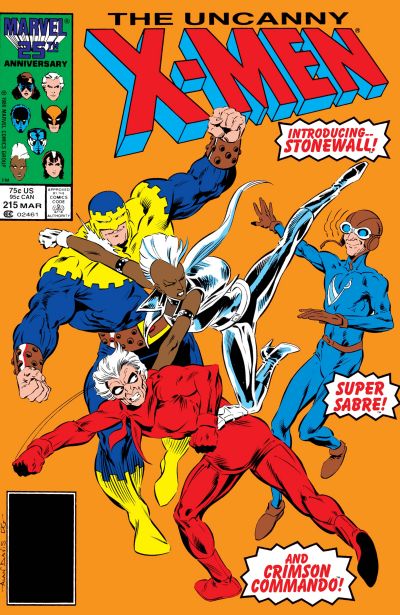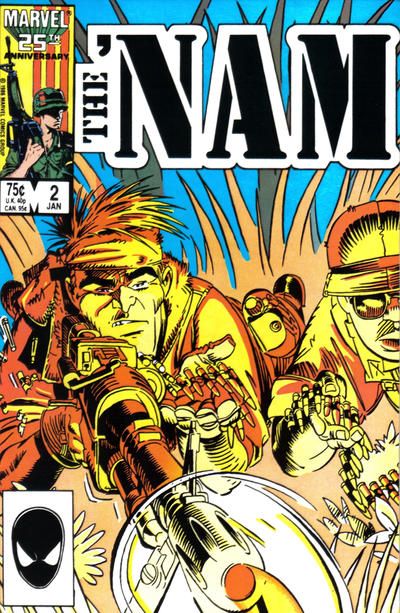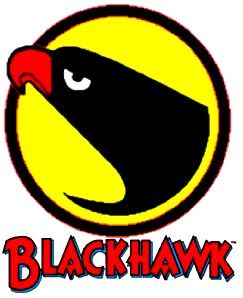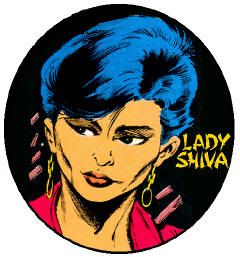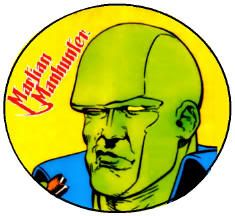Alpha Flight #45 had a wicked white Sasquatch cover where Kevin Nowlan inked June Brigman, who was then complimented by Whilce Portacio on the interiors. Brigman is still best known for co-creating Power Pack, and only did five issues of this book, which is too bad, because she was a good fit. For maximum bleakness, the issue starts with the glass casket burials of Snowbird, her husband, and the infant son she herself killed while possessed by the spirit of Pestilence. Top that, Aquaman! Also, Northstar was dying from fairy AIDS, Vindicator had lost confidence as a leader, Puck pined for her in a humiliating way, and Snowbird's corpse in Sasquatch form was resurrected by Pestilence. On the plus slide, the once seemingly dead Walter Langkowski helped defeat Pestilence and reclaim the body, but then he was a bit put out to realize that his human form was now a girl. Convoluted, but I liked it.
My half-brother continued buying the "Gang War" arc into its fourth chapter in
Amazing Spider-Man #287, as I more or less continue to recycle that opening sentence verbatim. This one had Daredevil, as was legally required of any major crime stories set in New York in the '80s. I was surprised to see Erik Larsen's name in the credits, and have to assume this was or very near to his introduction to the not-so-friendly neighborhood. I also assume the editor brought in Art Nichols to smother Larsen's eccentricities in drab late Bronze Age advertising art realism, because Larsen was already better than this hash. It's just plain hard to look at, especially when the Man without Fear turns up in a fat suit to trick Spider-Man into fighting him... and the Falcon... for reasons?
Ah jeez-- here comes
Captain America #328 and the debut of D-Man, wrestler turned (future) hero of the homeless. Not a champion for the homeless, but an unhoused super-hero. I feel like even in the Marvel Universe, someone who can lift 25 tons could manage gainful employment, but D-Man was a special kinda guy. By the way, this being an audio medium, that's d-apostrophe-man, not like Etrigan or that one guy from the Justice Machine. Short for Demolition Man, probably because Marvel was afraid Sting might sue. Demolition would have been a good gig to stave off homelessness. Anyway, Dennis Dunphy had been introduced a year earlier, during Ben Grimm's per-cancellation trend-chasing wrestling days. Cap was supposedly investigating the Power Broker that had given Super Patriot and his B.U.C.kies their strength & stamina, but was also considering the need to start juicing himself, as if Cap fans hadn't already heard enough steroid jibes. So this random mohawked wrestler dude decides to help Cap by putting on a variation of Dardevil original bumblebee costume with a Wolverine mask, except it was the current Wolverine instead of the old cat-mask, which he might have been able to get away with. And to top it off, Paul Neary gets inked by Vince Colletta, a real Vegemite and sardines combination for me. Change my relationship status back to "it's complicated" and skip the rest of this story arc.
Classic X-Men #7 had a striking cover-- literally the team knocking through a wall-- which has been referenced many times in the years since. As Arthur Adams goes, I found it a bit flat, and preferred the inside cover image of Storm in space gear. The expansion of the reprint story is more obvious this time, as the new pages and panels were drawn by Jim Sherman. Besides smoothing out some of the bad science while sending the X-Men on a space shuttle to battle Sentinels on a satellite, they also insert a subplot that explains why the Hellfire Club would be spearheading a project that would obliterate mutantkind. That leads into the John Bolton back-up, with the artist in his element, drawing salacious elites in Victorian garb, as they betray and murder one another. The back cover is a White Queen pin-up, but the star of the story is the Black King.
Daredevil #241 had the first and last appearance of the Trixter, spelled with an "x," as well as Todd McFarlane, though you can hardly tell once Al Milgrom smothered all the life out of him. Spider-Man and Daredevil have enough in common that you want to shoot for contrast, and McFarlane will become a premiere Spidey artist, so I'm not sure I'd have wanted the full Todd treatment, anyway. That said, Ann Nocenti is her usual weird, bleak self, and I have to wonder why Todd never tapped her for any Spawn material, because she was a natural fit for the kind of material Todd was always trying, and usually failing, to deliver. Look at this story really drive that home, but also reminded me that sometimes Ann Nocenti was too much for my taste with this gonzo grimdark Christmas misery.
I bought
Fallen Angels #1 because it was a heavily promoted X-Men tie-in with art by Kerry Gammill. Unfortunately, it was really a Sunspot mini-series where he runs away from the X-Mansion and gathers a bunch of misfits into a short-lived grouping, if never really a proper team. My brother would pick this up off and on, but myself and most of fandom washed our hands of it with a swiftness. I continued to read my half-brother's copies of
Fantastic Four Vs. X-Men into #3, mostly to see how one of my favorite X-people, Shadowcat, managed to survive her post Mutant Massacre drift into irrevocable immateriality. The drama over whether Mister Fantastic intentionally exposed his family to cosmic rays didn't do much for me. I clearly had Christmas cash from my father's family burning a hole in my pocket if I had the coin to spend on
Groo the Wanderer #26. Admittedly though, it was probably the best of the ones I read, as the imbecile gets shrunk by a pair of witches, and dose his own take on Sword of the Atom. It's a novel angle, and Sergio Aragones' detailing was in top form.
Mark Hazzard: Merc #6 I bought new at 7-11, and began a run of Mike Zeck covers that will last most of the rest of the series. However, I don't. I wonder if that Zeck connection made some of my memories of this title bleed into my enthusiasm for G.I. Joe. But what's weird is that I don't end up buying many or maybe any new, and the issues I enjoyed the most have a Mark Beachum association instead. Anyway, this one had Vince Giarrano art, which would normally have been a deal breaker, but this is in his early days when he drew in a more conventional style. Mark's pilot buddy Treetop gets the shop a gig guarding an actual former Nazi up for political office in a German-speaking country. Predictably, Mark almost immediately turns on the guys paying his bills, and seemingly kills one of the guy's guards at one point. There are "Never Forget" types who keep trying to out the politician, and one who had slept with Mark also ended up murdered in plain sight during a demonstration by another guard. Mark goes full Dalton in the last reel of Roadhouse, spending more time avenging the girl than we ever did with her while alive, killing scores with seeming impunity. Ultimately, Hazzard turns the politician over to... the media? Who are more interested in yet another old Nazi that they seemed intent on electing than the 6'4 scarred American running around with an Uzi. There were so many inkers that the credit went to Manny Hands, and I guess veering from a Kubert to a Salmons could have been more schizophrenic than this, but I get why I more or less quit here.
Once again, I paid a buck-fifty for
Mephisto Vs... The Fantastic Four #1, purely on the strength of that righteously Satanic cover that, in a rare reversal for me, should be plagiarized more often. I've seen it "homaged" once or twice, but this thing is sick and that sickness should have spread further. The interiors by John Buscema & Bob Wiacek are painfully conventional by comparison, not at all warranting the up-charge. However, Al Milgrom's story has a mean streak, as Mephisto forces appropriately forces Faustian deals on various heroes in pursuit of possessing the purest soul. The narrative leans into the horror, and is sturdy enough that DC ripped off the premise for a months-long intra-company crossover a decade later. One of my favorites, in fact, and that stoutness kept me coming back to this mini-series, as well.
The New Mutants #50 had so much gong on that I didn't even mind the Rick Leonardi cover, or even how that cover got ripped off not long after I bought it. Hey, the Jackson Guice Magik splash page looked better without it. Actually though, this may have been too busy. We start in Limbo, and then Magik teleports to the Shi'ar Empire. That brings in Professor X, Lilandra, the Starjammers, the Micronauts, Grimjack, and Munden's Bar. I obviously wouldn't have caught the First Comics references in 1986, but I'm pleased to see Claremont was a fan, too. The New Mutants were still in the fascist future, which I'm not sure ever gets addressed again, unless that's where Bishop came from? But Magik just picks up her team in a portal from that future, everyone does to Earth, and they fight a version of S'ym corrupted by the transmode virus before the title bout with Warlock's father, Magus. Not my Warlock, and not that Magus, which I confess to being slightly resentful about. I liked this issue fine, but for whatever reason, I was done with this book until getting dragged back for the next crossover, Fall of the Mutants.
I said last month that I was sticking around for
Psi-Force #6 and beyond, as long as Mark Texeira was delivering that sweet art. About that... under maybe his best cover of the run was a hideous Christmas story fill-in my Mike Vosburg and Al Milgrom. Six months in, I'm invested in these kids and their sob story holidays, but let's not push it with another lousy fill-in next month.
More evidence of my riches was
Star Trek Movie Special #2 at $2.00, I believe bought at the mall bookstore. Despite the issue numbering, it actually adapted the fourth and best of the movies, The Voyage Home. I think the creative team of Barr, Sutton, and Villagran also did the main Trek title, which I readily skipped, but I plucked down the pair of bucks for this here souvenir. Besides, unlike with The Search for Spock, I don't think they offered action figures for this one. I'm thinking the VCR might have finally come into the household around this time, but I could still see value in having the comics adaptation of a favored movie.
West Coast Avengers #19 is a rough read today, what with it centering on the old west Ghost Rider doping up Mockingbird to be his love slave, and both battering Kid Colt andc Two-Gun Kid when they try to do something about it. Also, Wonder Man's idiocy gets Hawkeye injured, and Clint uses a doomed past life of Firebird as a way to each out for help in the present, neglecting to mention to the poor woman the doomed part of the equation. Not a lot of heroism in this super-hero comic.
X-Factor #14 with Cyclops versus the Master Mold, although the true battle was with his burgeoning awareness that he's a sleezeball. Simonson gave the book a distinctive look, and I at least read my brother's copies, unlike when he'd pick up New Mutants.
I once again splurged on a $1.50 comic, maybe because I was having a good Cap month, at least so far, and bought
X-Men Vs. the Avengers #1. This was probably Marc Silvestri's audition of Uncanny X-Men, where he had a long run that I struggled with. He's so much better at drawing the Avengers, especially Captain America, although with John Buscema and Tom Palmer still on that title, it didn't seem to need saving. This very month offered the conclusion to the beloved Roger Stern arc "Under Siege," but in a year, that title's prospects become pretty bleak for much of the next decade. As for this Magneto-centric mini-series, well, I could have used Claremont here, because I wasn't entirely up for Roger Stern's serving of mutantkind. It was funny to see a Quinjet parked in front of a K-Mart on the splash page, given how much of my toy buying, including Secret Wars, was centered on one.


